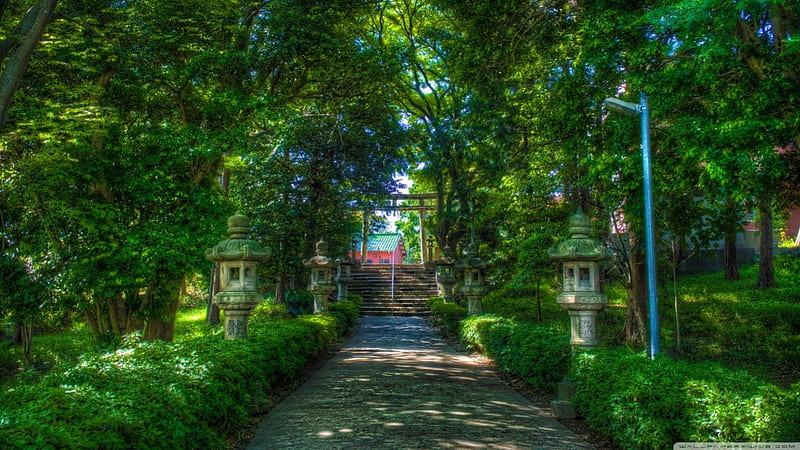
Whispers of the Ancients: Exploring the Sacred Serenity of Shinto Shrines

In the heart of Japan’s lush landscapes and vibrant cities, Shinto shrines stand as serene custodians of the nation’s spiritual heritage. These sacred spaces, imbued with the whispers of the ancients, draw visitors from all walks of life seeking solace and a deeper connection to nature and the divine. Each shrine, adorned with its distinctive torii gate and surrounded by wooded sanctuaries, invites a moment of reflection and reverence, allowing one to step away from the bustle of modern life.
As one traverses the pathways leading to these tranquil sites, the air thickens with a sense of peace and spirituality. The subtle rustling of leaves and the gentle trickle of nearby streams seem to carry the echoes of centuries. Here, the rituals and traditions of Shinto offer a glimpse into the harmonious relationship between humans and the kami, the spirits that inhabit the world. This exploration of Shinto shrines not only reveals the intricate beliefs and practices of this indigenous faith but also highlights the enduring allure of their serene beauty in a fast-paced world.
Historical Significance of Shinto Shrines
Shinto shrines serve as pivotal symbols of Japan’s cultural and spiritual heritage. Originating in ancient times, these sacred spaces were initially created to honor the kami, or spirits, believed to inhabit the natural world. The construction of shrines marks the beginnings of Shinto, reflecting the deep connection between the Japanese people and their environment. As communities evolved, so did the role of shrines, becoming not only places of worship but also centers for local festivities and communal gatherings.
Throughout history, Shinto shrines have witnessed significant events that shaped Japan’s socio-political landscape. The Edo period marked a golden age for shrine development, as the Tokugawa shogunate promoted Shinto as a means to consolidate power and unify the nation. During this time, many shrines were expanded and adorned with exquisite craftsmanship, further embedding them into the Japanese identity. The rituals and ceremonies held at these shrines reinforced the collective spirit of the people and the divine connection they felt to their ancestors and the kami.
The Meiji Restoration in the late 19th century signified another turning point for Shinto shrines. The government established Shinto as the state religion, emphasizing its role in fostering nationalism and cultural pride. This era led to the classification and preservation of shrines as important cultural treasures, initiating a renewed interest in their history and significance. Even today, Shinto shrines continue to be sites of worship and cultural celebrations, bridging Japan’s rich past with its present and ensuring that the whispers of the ancients echo through time.
Architectural Features and Aesthetics
Famous Shinto Shrines
Shinto shrines are a testament to Japan’s rich cultural heritage, showcasing a harmony between nature and artistry. These sacred spaces typically feature a distinctive torii gate, which serves as a symbolic entrance to the spiritual realm. The torii, often painted in bright vermilion, invites visitors to leave the mundane world behind and step into a place of reverence. The use of natural materials like wood and stone is prevalent, allowing the structures to blend seamlessly with their surrounding environments.
The roof designs of Shinto shrines are particularly noteworthy, often exhibiting elegant curves that mimic the soft lines of the landscape. Commonly thatched or made from cedar bark, these roofs not only provide shelter but also enhance the aesthetic appeal of the shrines. Many shrines are elevated with wooden platforms, allowing for an unobstructed view of the grounds and surrounding nature, reinforcing the connection between the spiritual and the earthly.
Decorative elements such as statues, carvings, and sacred objects further highlight the artistry present in Shinto shrine architecture. Many shrines feature unique symbols and motifs that reflect the local cultural heritage and the deities they honor. The tranquil setting, combined with the meticulous craftsmanship of the structures, invites visitors to immerse themselves in the serene beauty that characterizes these sacred spaces.
Rituals and Practices at Shrines
Shinto shrines are vibrant centers of cultural and spiritual life, where various rituals and practices unfold daily. One of the most common rituals is the ritual purification, known as temizu, which involves cleansing one’s hands and mouth at a water basin before approaching the shrine. This practice symbolizes the purification of the mind and body, allowing visitors to enter the sacred space with respect and clarity. The act of cleansing sets the tone for the entire experience, emphasizing the importance of purity in Shinto beliefs.
Another significant practice at Shinto shrines is the offering of prayers and wishes, typically done at the main hall or honden. Visitors may offer coins, bow twice, clap their hands twice, and then bow once more while silently expressing their wishes. This moment of connection allows individuals to seek guidance and protection from the kami, the spiritual beings revered in Shintoism. Additionally, many shrines feature ema, wooden plaques on which visitors write their prayers or intentions, leaving them hanging on a designated board or tree as a form of offering.
Festivals, known as matsuri, are also an essential aspect of Shinto shrine practices, celebrating the kami and fostering community spirit. These events often involve traditional music, dance, and food, creating a lively atmosphere that draws locals and visitors alike. Each shrine may have its own unique festivals, reflecting the local culture and history. Through these rituals and festivities, Shinto shrines serve not only as places of worship but also as vibrant hubs of community life, connecting the past with the present.
The Role of Nature in Shinto Beliefs
In Shinto beliefs, nature is revered as a sacred domain filled with divine spirits known as kami. These kami inhabit various elements of the natural world, such as mountains, rivers, trees, and even stones. This deep connection to nature reflects the belief that all living things possess a spiritual essence. Shinto shrines are often located in areas of breathtaking natural beauty, serving as a bridge between the human and the divine. The tranquility found in these environments enhances the worship experience, allowing practitioners to feel the presence of kami in their everyday lives.
The incorporation of natural elements into Shinto practices is also evident in rituals and festivals that celebrate seasonal changes. For instance, cherry blossoms in spring and rice harvests in autumn are significant events that reflect the gratitude towards the kami for their blessings. These observances emphasize the cyclical nature of life and the interconnectedness of humans with the environment. By participating in such rituals, adherents honor the spirits of nature while fostering a greater awareness of the seasonal rhythms and the importance of ecological harmony.
Furthermore, the architecture of Shinto shrines is designed to blend seamlessly with the surrounding landscape. Constructed using natural materials like wood and stone, these shrines invite visitors to appreciate the beauty of nature while engaging in spiritual practices. The carefully designed pathways leading to the shrines often mirror the natural contours of the land, encouraging a contemplative journey. This harmonious relationship between sacred spaces and the environment underscores how Shinto beliefs celebrate the intrinsic value of nature as a source of spiritual inspiration and connection.



